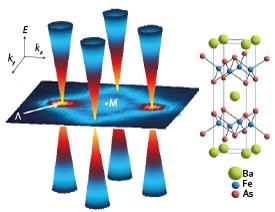

07/26/2010

The discovery of iron-based superconductors in 2008 reenergized the field of superconductivity research, all the more so because the electronic properties of these new compounds have proved to be complex and full of surprises. Few, however, would have expected that these superconductors would display features similar to those of another material that has recently attracted the excitement of scientists — graphene.
A team of researchers led by Takashi Takahashi of the WPI-AIMR had been studying the iron-based compound BaFe2As2 in order to gain new insights into its magnetic properties, particularly with respect to the ‘spin-density wave’ (SDW) order previously reported for this material. The team discovered that the compound has a Dirac cone-like electronic band structure1 — the same feature that gives graphene its exceptional properties.
BaFe2As2 is the parent compound of one member of the iron-based superconductor family. It is widely accepted that superconductivity in these iron-based compounds, as in the cuprate superconductors, is present in the parent compound but suppressed by another property, usually magnetism. The parent compound is induced into its superconducting state by adding impurity atoms and cooling it to extremely low temperature.
The researchers examined the parent compound BaFe2As2 using a technique known as angle-resolved photoemission spectroscopy, which revealed two bright points of photon emission in momentum space below the SDW temperature (Fig. 1). Focusing on these points and studying emission as a function of energy and momentum, the team then discovered the Dirac cone — a band structure that describes how electrons behave like massless relativistic particles at certain points in momentum space.
The similarity with graphene is not complete, however. While the Dirac cone of graphene is symmetric with respect to momentum, that for BaFe2As2 is distinctly asymmetric and displays small pocket-like features and nodes, features that present intriguing targets for future research.
The team’s results have broad implications for many of the actively studied topics in solid-state physics. Aside from graphene, Dirac cones have also been observed in ‘topological insulators’, a class of materials that are at once both insulating in the bulk and metallic at the edges. “Whoever would have thought that iron-based superconductors, one of the hottest materials in materials science, would exhibit low-energy physics similar to graphene?” says Pierre Richard, one of the lead researchers involved in the discovery. “With our findings, people will have to think more carefully on the connection between all of these materials, which could lead to the development of new functional materials with exotic properties.”
Richard, P., Nakayama, K., Sato, T., Neupane, M., Xu, Y.-M., Bowen, J.H., Chen, G.F., Luo, J.L., Wang, N.L., Dai, X., Fang, Z., Ding., H. & Takahashi. T. Observation of Dirac cone electronic dispersion in BaFe2As2. Physical Review Letters 104, 137001 (2010). | article
This research highlight has been approved by the authors of the original article and all information and data contained within has been provided by said authors.